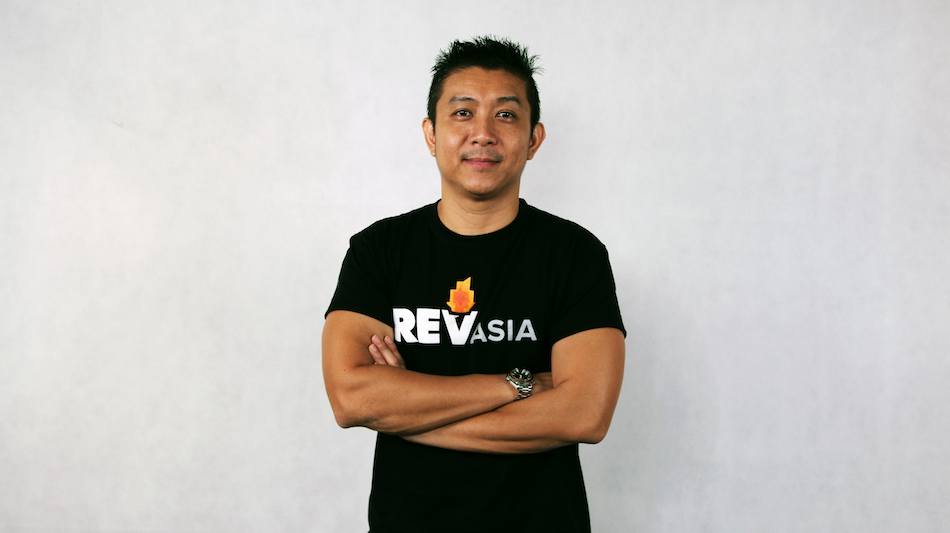
Tze Khay Voon, managing director of Rev Asia. Photo credit: Publicity.
The Rev Asia media group is arguably one of Malaysia’s top digital media conglomerates. With 12 sites, it targets the Malay, Chinese, and English-speaking audiences, covering news as well as niche topics, from Malaysia’s electronic dance music scene to how to make the best nasi goreng.
In September, the sites had over 4.7 million unique monthly visitors, a figure that’s undoubtedly gone up after it acquired three more local content portals in December.
Leading the charge for Rev Asia is its managing director, Tze Khay Voon. He’s been associated with the media arm of Catcha Group for over 10 years, with roles across sales, advertising, and strategy.
“I started my career in the late 1990s,” recalls Tze. “For the first two years, I sold advertising space in magazines. I joined Catcha Berhard during the early internet days back in 2000 as an online sales executive.”
Like most of his peers, Tze was sold on the prospect of a digital future. Patrick Grove’s Catcha was working aggressively to position itself as the Yahoo for Southeast Asia, and many considered it a hot prospect for an IPO. But the dot-com bubble in Silicon Valley hit hard and those plans were shelved.
Print is the new web

Photo credit: kaboompics.
Grove, now with a net worth of US$260 million, is credited with rescuing Catcha from the dot-com crash. Its media wing had to make big changes to be salvaged, pivoting to traditional publishing in order to stay afloat.
In 2002, Tze helped launch Juice, a magazine on urban culture in Malaysia. Catcha didn’t stop there – the next five to six years were spent rolling out more original magazines coupled with licensing deals to bring foreign publications to Malaysia.
“At the back of our heads we always wanted to come back to online businesses as we knew that would be the future,” explains Tze.
We knew we had to own and operate our own brands.
The first hints of this switch back to the web came in 2009 when Catcha was in talks with Microsoft to act as its exclusive sales partner and help build MSN Malaysia.
By this time Tze had taken on far more responsibilities. He wasn’t just tasked with meeting sales targets but was now heavily involved in overall management. Building a sustainable media business was one of his core metrics.
“The online business changed so fast and we felt the reseller model” – like with Microsoft – “wouldn’t work in the long run. We knew we had to own and operate our own brands. So we started to look at the opportunities and see what the emerging trends are around the world,” says Tze.
As the print magazines continued to churn out their monthly copies, senior management were preparing for the inevitable. They started talking to superstar internet entrepreneur Khailee Ng in 2012 about the possibility of acquiring Says, one of the many businesses he had started.
“The talks went on for six months, after which the official merger took place in October 2013. We injected all the assets of Catcha Media and Says into a special purpose vehicle called Rev Asia Berhad. 70 percent of this was owned by Catcha and the remainder by Khailee,” recalls Tze.
Identifying trends
Since then the media company has gone from strength to strength. It owns the publishing licenses for Business Insider in Malaysia, Singapore, and Indonesia. Juice has now evolved into a digital-only publication. Other sites like OhBulan and Rohjak boast millions of engaged users. And, most crucially, each and every business is profitable.
Companies were still very skeptical about advertising online.
Of course there have been challenges. As Rev Asia moved towards the digital space, it had to close down some print magazines, restructure, and lay off staff. A bigger hurdle was to convince its advertisers that they should reallocate their budgets for the internet. This required extensive coaching and dialogue to convince them of the efficacy of the digital world.
“How do you convince a brand who used to spend half a million ringgit a year on traditional advertising and then try to get them to an online platform?” smiles Tze. That’s over US$100,000. “Brands were still very skeptical how they’re going to spend online because they don’t see a physical product.”
“A lot of effort and education needed to be put in towards the client side. You have to show them research and case studies to ensure that they understand what we’re doing and the change in behavior. Because people are now buying magazines less and consuming bite-sized news on their mobile phones much more. That was one of the key strategies we employed.”

Photo credit: Pixabay .
Focus on building teams
At the same time there was a concerted effort to ensure the germination of a vibrant and cohesive culture across Rev Asia. The team identified core values that it still holds dear: go for growth; work faster; communicate better; don’t be so serious; do the right thing; and care.
Tze sees this adherence to culture as one of the key facets behind building a profitable online media business. It’s not easy to adapt in this space and one of the reasons they’ve managed to do so is because they remain nimble, agile, and concentrate on hiring exceptional talent.
“We emphasize a lot on transparency,” he notes. “When you have great people working for you, the product automatically becomes phenomenal. And when the product is phenomenal, consumers will love you and your brand will grow.”
Rev Asia is sanguine about the future of digital consumption in Southeast Asia. With over 600 million internet users in the region, Tze points to the stratospheric growth of mobile devices as an indicator that the market isn’t going to cool down anytime soon. But at the same time, the team’s concentrating on dominating Malaysia alone for now. Expansion into other markets may come in 2018 and beyond.
With all this experience under his belt, Tze has advice for budding entrepreneurs.
“I had to quickly evolve by connecting closely and learning from my younger peers, and continue to persevere despite experiencing some initial failures,” Tze says. “I learnt never to give up despite the obstacles […]. These are the two strong principles I live by today.”
This post He’s building a digital media goliath in Malaysia appeared first on Tech in Asia.
from Tech in Asia https://www.techinasia.com/tze-khay-rev-asia
via IFTTT
No comments:
Post a Comment